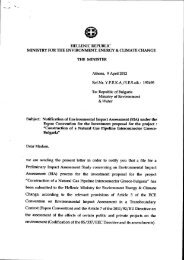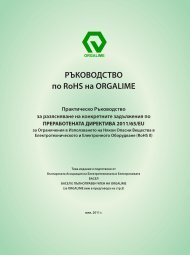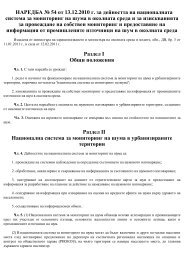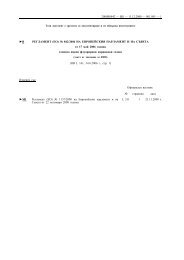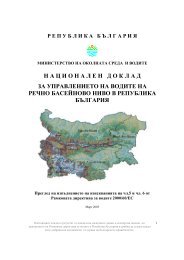Програма на научната конференция - Министерство на ...
Програма на научната конференция - Министерство на ...
Програма на научната конференция - Министерство на ...
- No tags were found...
You also want an ePaper? Increase the reach of your titles
YUMPU automatically turns print PDFs into web optimized ePapers that Google loves.
TAXONOMIC STRUCTURE CHANGES AND DOMINANCE PATTERNSOF PHYTOPLANKTON COMMUNITIES IN BULGARIAN BLACK SEACOASTAL WATERS – CASE STUDY BURGAS BAYR. Mavrodieva 1 , S. Moncheva 1 , G. Hiebaum 21Institute of Oceanology, Bulgarian Academy of Sciences, 9000 Varna, P.O.Box152. e-mail: rmavr@abv.bg, snejanam@abv.bg; office@io-bas.bg 2 CentralLaboratory of General Ecology, Bulgarian Academy of Sciences, 1113 Sofia,2 Y. Gagarin Str. e-mail: hiebaum@ecolab.bas.bgThe long-term taxonomic structure of phytoplankton in the Black Sea demonstratea likely shift from a diatom (autotrophic species) dominant system to an apparentdominance of opportunistic dinoflagellates including mainly mixo- andheterotrophic species during the 80-ies, a partly regained dominance of diatoms inthe late 90-ies- early 2000s to an increased share of microflagellates during 2001-2007 (Moncheva in Nesterova et al., 2008). The aim of this paper is to analyse thephytoplankton taxonomic structure changes, dominance patterns and diversity ofphytoplankton communities in relation to a complexity of environmental factors.The study was carried out in the Southern part of the largest Bulgarian Bay (BurgasBay) from 2000 to 2005. Samples for phytoplankton and related environmentalparameters were collected on monthly bases. Biodiversity indices (speciesrichness, species diversity, species evenness) and statistical methods (PCA, CCA)were applied to the community analyses. Historical data were used to assess thecurrent changes in the phytoplankton assembly and evaluate patterns ofphytoplankton succession. The new dinoflagellates species Azadinium spinosumElbrächter & Tillmann, 2009 and Lessardia elongata Saldarriaga et F.J.R.Taylor,2003 was present along with other not detected so far or very rare species (Euglenaacusforme, Gyrodinium varians, Protoperidinium sinaicum) signifying furtherdiversification of the planktonic community (Nesterova et al., 2009). Thephytoplankton attributes were used as biological quality indicators for scaling theecological quality of the area sensu WFD according to the existing classificationscheme (Moncheva & Slabakova, 2007). The deviation from classical successiondynamic, relatively low abundance and biomass, high species richness of mixoandheterotrophic species, the presence of not detected so far or very rare speciesare signals for disturbance in the phytoplankton community.88







